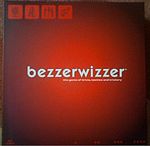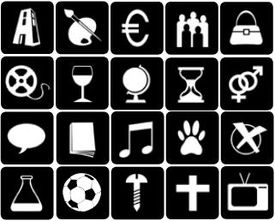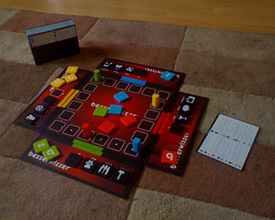
- Tabletop games
- Board games
- Tile-based games
- Turn-based games.html
- Abstract strategy games
- card games
- Connection games
- Mancala games
- Paper-and-pencil games
- Word games



| the game of trivia, tactics and trickery. | |
|---|---|

Cover Image
|
|
| Manufacturer(s) | Mattel, Bezzerwizzer ApS |
| Years active | 2006-present |
| Players | 2-4 teams |
| Age range | Aimed at 15+ |
| Playing time | 45 minutes |
| Random chance | Low - Moderate (Question Categories) |
| Skill(s) required | General knowledge, tactics |
Bezzerwizzer is a trivia game combining trivia and tactics. The game was invented in 2006 by the Dane Jesper Bülow. The name "Bezzerwizzer" comes from the originally German term "Besserwisser", meaning "know-it-all".
Mattel has released versions for the United Kingdom, France, Germany, and the United States
In Denmark there are three different editions of Bezzerwizzer, developed by the Danish company Bezzerwizzer ApS. Until now Bezzerwizzer ApS has sold more than 100,000 Bezzerwizzer games in Denmark. Bezzerwizzer ApS has also launched the game in Finland, Norway, Sweden, the Netherlands and Belgium.
 Bezzerwizzer Tiles
Bezzerwizzer TilesBezzerwizzer combines trivia with tactics, and it can be played in teams or individually. The questions are divided into 20 different categories, each built upon different topics (in alphabetical order):
Players are split up into teams, most of the time playing separately. Each team selects a playing piece and takes two Bezzerwizzer tiles (denoted by the letter b) and one Zwap (denoted by the letter z) tile of the same color.
Each team then draws four category tiles (see picture above) at random from the bag, and places them on their tile board in order of preference. Each question has a point value determined by the number of dots above it. For example a team may pick the tiles Music, Film, Food and Politics. If they are confident at getting a question in one subject right they would put it on the fourth square on the board (scoring four points for a correct answer). There is no obvious varying difficulty between questions. Tiles cannot swap positions after being put down.
The team that plays first is chosen randomly by picking one playing piece from the bag - the owner of the playing piece goes first, though going first has no real advantage.
 The Bezzerwizzer Game Board
The Bezzerwizzer Game BoardFor every point scored a team moves forward one square.
Play goes in a clockwise direction from the team who plays first. The team will be asked their one point question first based on the topic they put on their board. The team answers the question and score the corresponding number of points if they answer correctly. An incorrect answer has no penalty. During their team's turn a team may use their Zwap tile. This allows this team to swap any two tiles (once those questions haven't been asked in that round). They may swap two tiles between any two teams or swap the two tiles of the same team (including their own) to produce a different order. Teams may play one tile during a round.
After all questions have been asked once - this will be 16 questions if four teams are playing - the round ends. The game continues as normal after four category tiles are picked again.
The first team to reach the finish is the winner, provided that another team hasn't also reached the finish in the same round. If two or more teams finish in the same round then sudden death occurs. Each team takes one playing piece out of the bag and gets a single question on that. If that team is wrong they are out. Teams may only remain in sudden death if they get their question right or all teams in sudden death get their question wrong. The last team in, is declared the winner.
If a defending team is situated on the home stretch (within the last five squares of the board), another attacking team may force them to go backwards. This is done by playing a Bezzerwizzer tile, which may choose to move the defending team's piece backwards (the same number of points) instead of moving forwards themselves. Assuming that the attacking team gets the answer correct and the defending team gets the answer wrong.